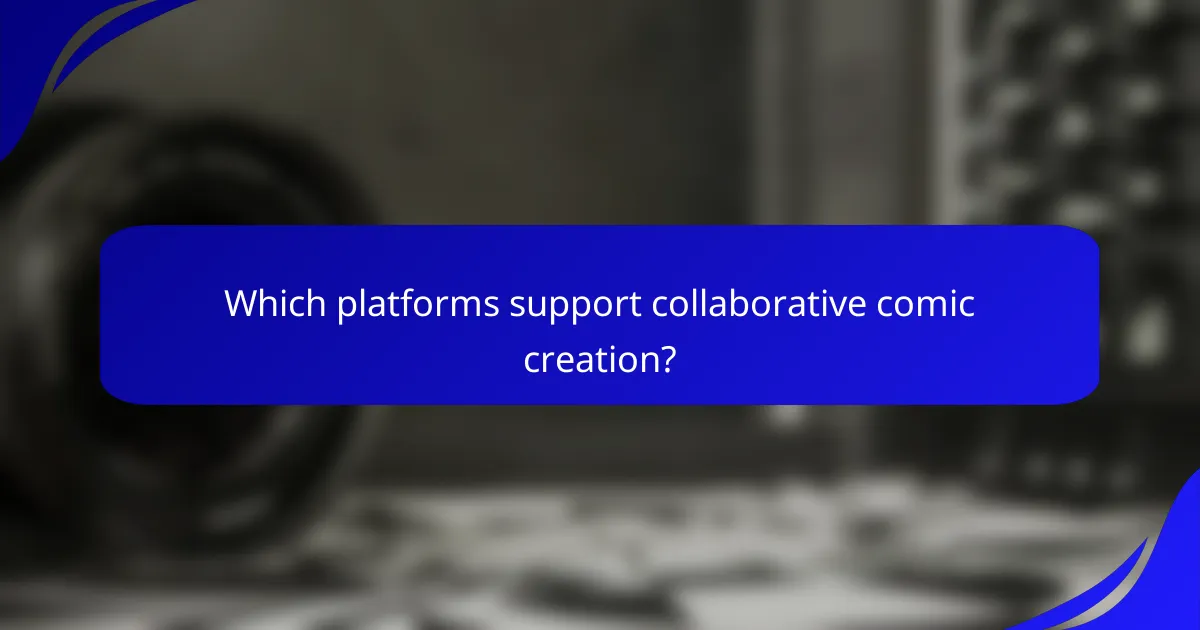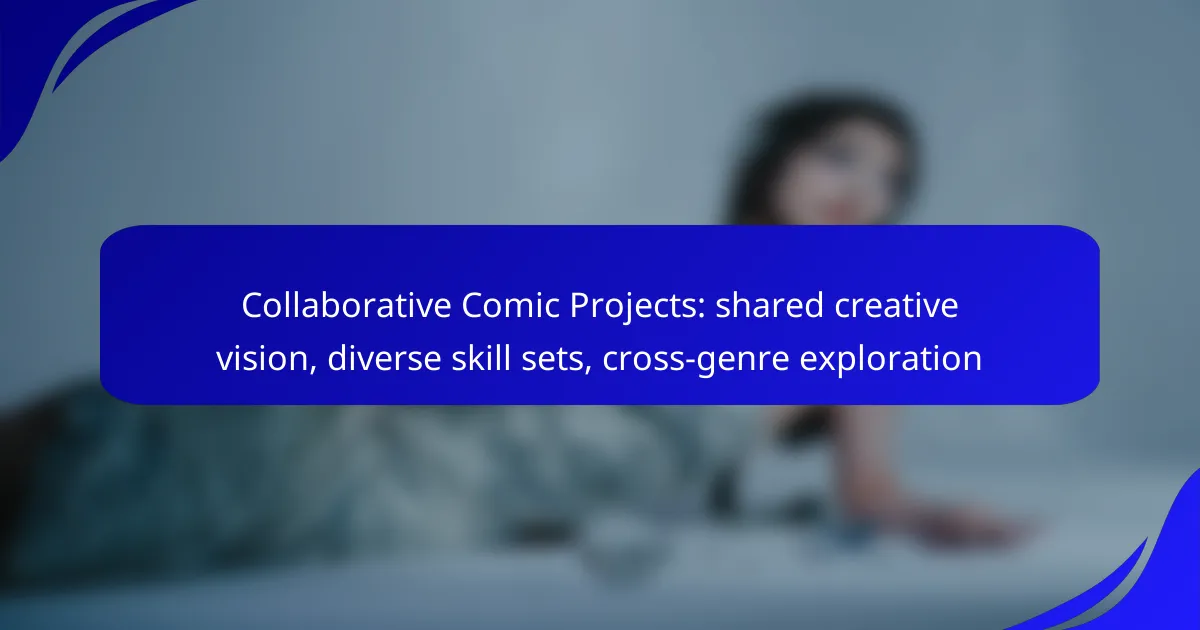Collaborative comic projects bring together diverse creatives to share a unified vision, leveraging their unique skills to enhance storytelling. By exploring cross-genre themes, these collaborations not only broaden artistic expression but also attract a wider audience. Utilizing various platforms designed for teamwork, artists and writers can seamlessly manage their projects and foster innovative ideas.

How to initiate collaborative comic projects in major cities?
To initiate collaborative comic projects in major cities, start by gathering a group of creatives who share a passion for storytelling through comics. Establishing a clear vision and understanding each member’s strengths will help streamline the creative process and foster innovation.
Define shared creative vision
A shared creative vision is essential for any collaborative comic project. It involves aligning on themes, styles, and goals that resonate with all team members. This can be achieved through brainstorming sessions, where ideas are openly discussed and refined until a unified direction emerges.
Consider creating a mission statement that encapsulates the project’s essence. This statement can serve as a guiding reference throughout the creative process, ensuring everyone remains focused on the shared objectives.
Identify diverse skill sets
Recognizing the diverse skill sets within your team is crucial for a successful collaboration. Each member may bring unique talents, such as writing, illustration, coloring, or digital design. Conducting a skills inventory can help identify these strengths and assign roles accordingly.
For example, if one member excels in character design while another specializes in plot development, clearly defining these roles can enhance productivity and creativity. This diversity can lead to richer storytelling and more engaging visuals.
Establish communication channels
Effective communication is vital in collaborative comic projects. Establishing clear channels, such as group chats, video calls, or project management tools, can facilitate ongoing dialogue and feedback. Regular check-ins can help keep everyone on track and address any concerns promptly.
Consider using platforms like Slack or Discord for real-time communication, and tools like Trello or Asana for project management. This ensures that all team members are informed and engaged throughout the creative process.
Set project timelines
Setting realistic project timelines is essential for maintaining momentum in collaborative comic projects. Break the project into manageable phases, each with specific deadlines. This approach helps keep the team accountable and allows for timely adjustments if needed.
For instance, you might allocate a few weeks for script development, followed by several weeks for artwork. Ensure that deadlines are flexible enough to accommodate creative processes while still providing structure.
Utilize online collaboration tools
Online collaboration tools can significantly enhance the efficiency of comic projects. Platforms like Google Drive or Dropbox allow for easy sharing of files, while software like Clip Studio Paint or Adobe Creative Cloud enables real-time collaboration on artwork.
Using these tools can streamline the workflow, making it easier for team members to contribute and provide feedback. Ensure that everyone is familiar with the chosen tools to maximize their effectiveness and minimize technical difficulties.

What are the benefits of cross-genre exploration in comics?
Cross-genre exploration in comics allows creators to blend different styles and themes, enhancing creativity and broadening appeal. This approach not only attracts varied audiences but also enriches storytelling and encourages unique artistic expressions.
Attract diverse audiences
By merging genres, comics can appeal to a wider range of readers. For instance, a comic that combines elements of fantasy and science fiction can attract fans from both genres, increasing its potential readership.
To maximize audience reach, consider incorporating popular tropes from various genres. This can include mixing humor with horror or romance with action, which can draw in different demographic groups and enhance marketability.
Enhance storytelling depth
Cross-genre narratives often provide richer storytelling opportunities. By integrating different genre conventions, creators can explore complex themes and character arcs that resonate on multiple levels.
For example, a story that blends mystery with romance can create suspense while developing emotional connections. This layered approach can lead to more engaging plots and memorable characters.
Encourage innovative art styles
Merging genres can inspire artists to experiment with diverse visual styles. A comic that combines elements of surrealism with traditional superhero art can lead to striking and original illustrations.
Artists should feel free to borrow techniques from various genres, such as using vibrant colors typical of fantasy in a noir setting. This not only enhances the visual appeal but can also set the comic apart in a crowded market.

Which platforms support collaborative comic creation?
Several platforms facilitate collaborative comic creation by providing tools for artists and writers to work together, share ideas, and manage projects. These platforms cater to various aspects of comic production, from storytelling to funding and community engagement.
Webtoon for web comics
Webtoon is a popular platform for publishing web comics, allowing creators to share their work with a global audience. It supports collaborative projects by enabling multiple contributors to upload their comics, manage episodes, and engage with readers through comments.
When using Webtoon, consider the format and style of your comic, as vertical scrolling is the standard. Collaborators can easily communicate through the platform’s messaging system, streamlining the creative process. Aim for consistent updates to keep your audience engaged.
Kickstarter for funding
Kickstarter is an effective platform for securing funding for comic projects, allowing creators to present their ideas to potential backers. By setting funding goals and offering rewards, teams can attract financial support while building a community around their work.
To succeed on Kickstarter, clearly outline your project, including timelines and budget breakdowns. Engaging visuals and a compelling narrative can help capture interest. Typically, campaigns run for 30 days, so plan your promotional efforts accordingly to maximize visibility and funding potential.
Discord for community engagement
Discord serves as a dynamic platform for community engagement, enabling creators to connect with fans and fellow artists in real-time. By creating a dedicated server, comic teams can foster discussions, share updates, and collaborate on ideas in a structured environment.
Utilize channels for different topics, such as brainstorming, feedback, and announcements. Regularly host events like Q&A sessions or live drawing streams to keep the community active. Remember to establish clear rules to maintain a positive atmosphere and encourage respectful interactions among members.

What criteria should be considered for team selection?
When selecting a team for collaborative comic projects, it’s crucial to consider artistic compatibility, storytelling strengths, and the availability and commitment of each member. These criteria ensure that the team can effectively work together toward a shared creative vision.
Evaluate artistic compatibility
Artistic compatibility involves assessing how well team members’ styles and techniques align. Look for artists whose work complements each other, whether through similar aesthetics or contrasting styles that can enhance the overall project. A shared vision for the comic’s look and feel is essential for a cohesive final product.
To evaluate compatibility, consider creating a mood board or reference images that reflect the desired artistic direction. This can help team members visualize how their individual styles will mesh. Regular discussions about artistic choices can also foster alignment and address any discrepancies early on.
Assess storytelling strengths
Each team member should bring unique storytelling strengths to the table, whether in plot development, character creation, or dialogue writing. Identifying these strengths allows the team to assign roles effectively, ensuring that each aspect of the narrative is handled by someone skilled in that area.
Conducting a brief assessment of each member’s past work can provide insight into their storytelling capabilities. Consider asking team members to share examples of their best narratives or character arcs, which can help clarify how their strengths can contribute to the project.
Consider availability and commitment
Availability and commitment are critical factors in ensuring that the project progresses smoothly. Team members should have the time to dedicate to the project without overcommitting themselves to other obligations. A clear understanding of each member’s schedule can help set realistic deadlines and expectations.
Establish a timeline for the project and discuss individual workloads upfront. Regular check-ins can help maintain accountability and allow for adjustments if someone is struggling to keep up. It’s essential to foster an environment where team members feel comfortable communicating their availability and any potential conflicts that may arise.

How to manage creative differences in a team?
Managing creative differences in a team involves establishing clear communication and conflict resolution methods. By fostering an environment where diverse ideas can be shared and respected, teams can effectively navigate disagreements and enhance their collaborative efforts.
Establish conflict resolution strategies
Implementing conflict resolution strategies is crucial for maintaining harmony in a creative team. Consider adopting methods such as mediation, where a neutral party helps facilitate discussions, or setting up a structured process for addressing disagreements. This can prevent conflicts from escalating and ensure that all voices are heard.
For example, teams can agree on a step-by-step approach: identify the issue, discuss it openly, explore solutions, and reach a consensus. This structured method can help keep discussions focused and productive.
Encourage open feedback sessions
Regular open feedback sessions create a safe space for team members to express their thoughts and concerns. These sessions should be scheduled consistently, allowing everyone to share their perspectives on ongoing projects and creative directions. This practice not only builds trust but also encourages collaboration and innovation.
To make feedback sessions effective, establish ground rules such as constructive criticism and active listening. This ensures that feedback is received positively and leads to actionable improvements.
Define roles and responsibilities
Clearly defining roles and responsibilities helps minimize misunderstandings and overlaps in a creative team. Each member should have a specific area of focus that aligns with their strengths, which can enhance efficiency and accountability. This clarity allows team members to contribute effectively without stepping on each other’s toes.
A simple way to define roles is to create a responsibility matrix that outlines who is responsible for what tasks. This can be reviewed and adjusted as projects evolve, ensuring that everyone remains aligned with the team’s goals.
